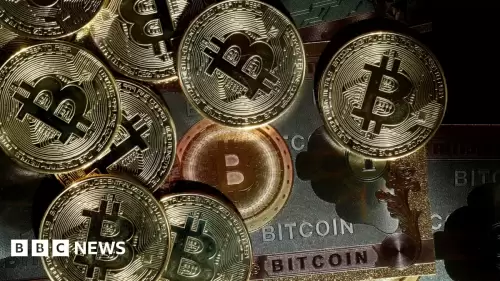 |
|
 |
|
 |
|
 |
|
 |
|
 |
|
 |
|
 |
|
 |
|
 |
|
 |
|
 |
|
 |
|
 |
|
 |
|
Cryptocurrency News Articles
Stablecoins Market Cap Exceeds US$230 Billion, Year-on-year Increase of 54%
May 21, 2025 at 10:03 am
The latest report released by Citi GPS shows that as of April 2025, the total circulation of stablecoins has exceeded US$230 billion

The latest report by Citi GPS shows that by April 2025, the total circulation of stablecoins has exceeded US$230 billion, displaying a 54% year-on-year increment from April 2024.
The market is now dominated by two giants, Tether (USDT) and USD Coin (USDC), which together take up over 90% of the market share in terms of trading volume and transaction value.
In recent years, the transaction volume of stablecoins has rapidly grown. Adjusting the data, we can see that the monthly transaction volume of stablecoins in the first quarter of 2025 has reached 650 billion to 700 billion US dollars, almost double the level seen in the same period from the second half of 2021 to the first half of 2024. The main applications are still focused on supporting the cryptocurrency trading ecosystem.
Apart from its role in the cryptocurrency field, stablecoins are also gradually becoming a key tool in the cross-border payment system. The Citi GPS report indicates that the transaction volume of stablecoins is expected to surpass the existing transaction volume of VISA and Mastercard in the future. Though still in its early stages of development, the trend is clear.
As Matt Blumenfeld, PwC's US and global digital asset leader, mentioned, more banks and traditional financial institutions will join the market. USD stablecoins are expected to continue dominating, and the number of participants will depend on the diversity of products catering to different scenarios. In the future, the competitive landscape of the stablecoin track may exceed that of the existing card organization system.
Financial technology giants accelerate their layout
Changes in the U.S. digital asset regulatory environment are profoundly affecting corporate payments, capital flows, and asset management methods. The new SEC Chairman Paul S. Atkins is expected to bring clearer regulatory expectations to the crypto industry, which is actively welcomed by the industry.
a16z stated that stablecoins have reached a level of popularity that can completely change the global payment system, just as WhatsApp has revolutionized international communications. Currently, financial giants are gathering to enter the market and compete for the stablecoin payment market.
Circle Payment Network
USDC issuer Circle has officially launched Circle Payments Network (CPN), aiming to solve the long-standing problems of cross-border payments such as multiple intermediaries, complex compliance, and fragmented legal jurisdictions, especially providing efficient and modern payment solutions for emerging markets.
CPN creates an Internet-based payment experience, realizes global real-time settlement of funds, and ensures compliance, including licenses, AML/CFT, network security, risk management, etc. The first batch of partners include banks, financial technology companies, payment and remittance service providers and USDC strategic partners. In the future, we hope to compete head-on with traditional payment networks such as Mastercard and Visa.
In addition, CPN supports third-party developers to build diversified financial service scenarios based on smart contracts and modular APIs. It has currently cooperated with large global banks such as Banco Santander, Deutsche Bank, Societe Generale, and Standard Chartered Bank.
Circle CEO Jeremy Allaire said that CPN will simplify remittances to be as convenient as sending an email, which not only consolidates Circle's position in the global financial services field, but also verifies the transformative value of stablecoins in efficient, compliant and real-time payments.
Stripe Stablecoin Application
Stripe has launched a new product portfolio based on AI and stablecoins to help businesses grow their payments. Its Payments Foundation Model relies on tens of billions of transaction data to improve anti-fraud and payment authorization rates, and is particularly good at identifying card testing attacks.
At the same time, Stripe launched Stablecoin Financial Accounts, which supports enterprises in 101 countries to use stablecoins for payment (currently supports USDC and USDB , and will be expanded to more currencies in the future). In addition, through the Bridge platform, it cooperates with Visa to issue bank cards bound to stablecoin wallets, allowing users to directly consume stablecoins at merchants that accept Visa. Bridge CEO Zach Abrams said that this innovation is an important step in integrating stablecoins into daily payments.
Stripe CEO Patrick Collison emphasized that AI and stablecoins are rapidly releasing business dividends. In 2024, AI functions will help Stripe's total payment volume increase by 38%.
Global Dollar Network (USDG)
Visa is planning to join the Global Dollar Network (USDG) alliance led by Paxos, a US compliant stablecoin issuer, and become the first traditional financial institution to participate in the alliance. The alliance brings together leading companies such as Robinhood, Kraken, Galaxy Digital, Anchorage Digital, Bullish, and Nuvei, focusing on improving the interoperability, liquidity, and revenue sharing mechanism of stablecoins.
USDG launched a stablecoin anchored to the US dollar in November last year, aiming to increase the global application rate of stablecoins and bring
Disclaimer:info@kdj.com
The information provided is not trading advice. kdj.com does not assume any responsibility for any investments made based on the information provided in this article. Cryptocurrencies are highly volatile and it is highly recommended that you invest with caution after thorough research!
If you believe that the content used on this website infringes your copyright, please contact us immediately (info@kdj.com) and we will delete it promptly.






























































